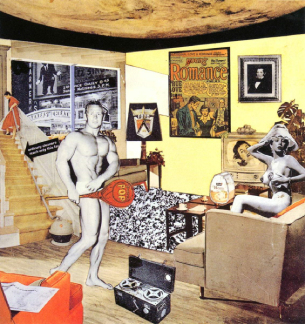The Pop (Popular) Art movement began in the 1950s and ended in the 1970s. It was the portrayal of common everyday objects as popular culture, especially for use in advertising and television. It began in the mid-1950s in Britain. In a 1958 edition of the Architectural Digest, Britain’s Lawrence Alloway described post-war work as pop art. He described the works as focusing on consumerism and materialism. Pop art challenged abstract expressionism and broke the barriers between consumer art and fine art. It was a movement to show that mass-produced images of everyday objects can become art.
Pop art took materials from context and placed them in a different background or with other objects. Pop artists questioned the traditions of Abstract Expressionism and provided different attitudes to their works. Pop art usually took on a humorous, critical, and ironic tone in order to make commentary on society and culture.
Richard Hamilton and Eduardo Paolozzi led the movement in London in the 1950s. They were both members of the Independent Group. In the 1960s, the movement was led by the artists, Peter Blake, Patrick Caulfield, David Hockney, Allen Jones, and Peter Phillips. Soon after, American pop artists, Jim Dine, Roy Lichtenstein, and Robert Rauschenburg carried on the movement into the United States. Pop art began in both countries as a positive response to the post-World War II era and the growing economy in society. One of the most famous Pop artists is Andy Warhol. He is especially known for his images of the Campbell soup cans, the Brillo soap boxes, and Marilyn Monroe. He used a printmaking technique called seriagraphy in his art to mass-produce photo-like images. He focused on popular media and advertisements.
Capitalist Realism was later driven by German artist Gerard Richter as a derivation of the Pop Art movement.

Here is an image by Richard Hamilton, a pop artist. He takes objects of everyday life and places them with other objects to create an otherworldly image. It breaks traditions of abstract art and fine art. It is almost uncomfortable to look at because of its common feel.

This image of Marilyn Monroe is the popular art of Andy Warhol. The contrasting colors and the realistic nature of it represents Pop Art. It is also a focus on media and celebrities.

Finally, the image of Andy Warhol’s campbell soup cans is a clear representation of seriagraphy. He repeats an image continuously with slight changes (in the words) and uses an everyday item, a soup can. The bright color red against the white stands out.
In all of our macbooks, we have Photo Booth. One of the backgrounds is an example of Pop Art. The one that is divided into 4 colorful sections is commonly known as a form of Pop art. Pop art is available everyday in our life. It was created to decrease the harsh definition of what can be considered fine art.
My source: http://wwar.com/masters/movements/pop_art.html

